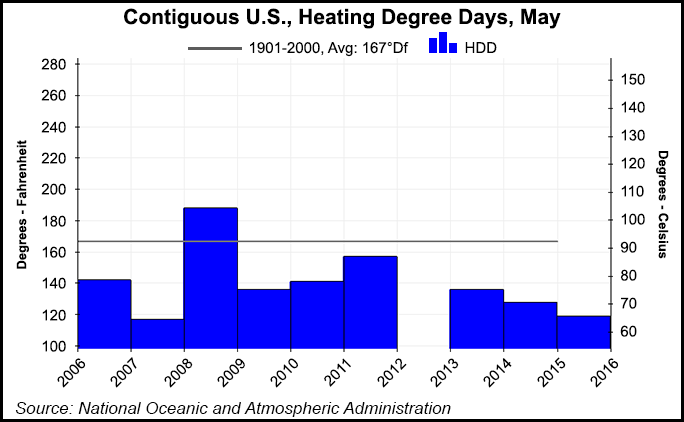Markets | NGI All News Access | NGI The Weekly Gas Market Report
NatGas Forwards Prices Rise on Slowing Production Potential, Winter Relapse
A string of cold snaps, which could be the last of the season, and signs of slowing production kicked natural gas forwards up a few notches between April 1 and 7, NGI Forward Look data shows.

The Nymex May contract climbed 6.3 cents during that time, while prices nationally were up 8.2 cents.
The strength comes despite bearish storage news from the U.S. Energy Information Administration, which reported a 12 Bcf build to stocks for the week ending April 1.
Inventories ended the traditional withdrawal season at a record 2,480 Bcf, some 1,008 Bcf above last year and 874 Bcf above the five-year average.
But market players brushed off the storage news and looked forward to a continuation of the alternating, thermometer-boosting cold fronts wandering through the Midwest and along the populous East Coast over the last few weeks.
A strong spring storm and associated cool blast tracked off the eastern U.S. Friday with showers and thunderstorms, but a more impressive cold front is forecast to immediately follow, according to forecasters with NatGasWeather. As far as the East Coast is concerned,
“Spring is in remission,” according to one weather watcher.
The second cold front is expected to sweep across the Midwest and East Friday and Saturday, while tapping a heftier dose of sub-freezing temperatures to bring a quick surge in natural gas demand, including relatively deep into the Southeast, where lows of 30s are expected, the forecaster said.
And while yet another weather system is forecast for the middle of next week in the far northern U.S., it should tap less Canadian air and not extend as deep into the U.S., forecasters said.
Furthermore, by late next week, any weather systems tracking across the U.S. won’t have opportunity to tap into the truly frigid cold pool over Canada because it will have eroded significantly due to the strengthening sun angle, NatGasWeather said.
“We continue to view weather patterns as somewhat bearish, but increasingly so after the Friday-Saturday system plays out as any storms over the U.S. after won’t be very cold,” NatGasWeather said.
“Prices sure found strength yesterday, so it will be very interesting to see if that can continue with the last throws of colder winter weather systems about to end,” it said.
One possible boost to prices could come from production, which is beginning to show signs of slowing.
Spring Rock Daily Pipe Production data has April 8 volumes at 72.97 Bcf/d, putting the last 30-day average at 72.9 Bcf/d, according to Genscape.
Genscape, based in Louisville, KY, is a real-time data and intelligence provider for energy and commodity markets.
“This is actually a 0.4 Bcf/d increase over last year’s same period average, but our Spring Rock production group is indicating we’re nearing the end of year-over-year increases,” Genscape said.
Spring Rock’s most recent forecast issued March 25 is calling for April 2016 volumes to show modest increases over April 2015; May 2016 to be nearly flat to May 2015; and then all subsequent months showing year-over-year declines until well into 2017, Genscape said.
Taking a closer look at forward curves, most markets’ gains for the week mimicked those of the Nymex.
New England’s strength, however, was more pronounced as this last blast of winter coincides with a summer-long maintenance event along the Algonquin Gas Transmission Pipeline (AGT).
AGT citygates May jumped 17.3 cents between April 1 and 7 to reach $2.56, according to NGI’s Forward Look. This compares with a national average of 8.2 cents.
AGT June climbed 13.5 cents to $2.72, compared to a 6.8-cent national average, while the balance of summer (July-October) rose 13.6 cents to $2.82, compared to a 5.4-cent national average, Forward Look data shows.
“Round after round of these cool blasts have come in the midst of major spring maintenance events, which has prompted AGT to issue an OFO effective until May 1,” said Erik Fabry, a natural gas analyst at Genscape.
The current maintenance work taking place at the Stony Compressor has limited throughput to just 1.15 Bcf/d, placing pressure on the system and downstream receipt interconnects, Fabry said.
Operational capacity through Stony Point was elevated to 1.4 Bcf/d on April 7 but will be restricted to a new year-to-date low of 1.03 Bcf/d on April 9, he added.
Meanwhile, over in the Pacific Northwest, the Northwest Pipeline at Sumas was the only price point tracked by Forward Look to end the week in the red.
Despite a double-digit jump in April 7 trading, NWP-Sumas saw May prices fall 1.1 cents between April 1 and 7 to reach $1.16. June was up 2.4 cents to $1.26, but even this gain was much smaller than the 6.8-cent national average for June.
NWP-Sumas’ balance of summer (July-October) was up 4.7 cents to $1.73, more closely in line with the national average of 5.4 cents.
The weakness at the front of the Sumas curve could be attributed to lower demand in the Northwest, which declined 0.5 Bcf/d over the past week to average 1.2 Bcf/d, according to Bentek Energy.
Northwest demand is expected to continue falling through June, dropping to 1.1 Bcf/d, the company said.
© 2024 Natural Gas Intelligence. All rights reserved.
ISSN © 1532-1231 | ISSN © 2577-9877 | ISSN © 1532-1266 |
